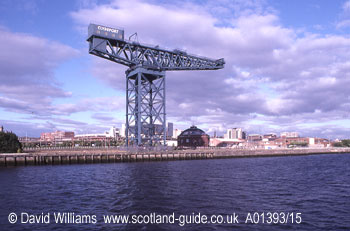By the time that Thomas Telford had further deepened the River Clyde, steamboats were regularly plying the river, shipyards were further developed and huge docks were built to accommodate the massive amounts of goods brought into and taken out of the city. All this rapid development was put under the control of the Clyde Navigation Trust and the Clyde soon became one of the most important industrial rivers the world has ever seen (see picture). Shipbuilding was to be the river`s most important export and the phrase `Clyde built` became known the world over as a guarantee of first-class workmanship.
But times have changed. Most of the yards have now gone, as have most
of the docks. As a consequence, few ships are seen on the river nowadays,
certainly in the centre of the city, although the tradition of cruising
`Doon the Watter` is kept alive by the paddleship Waverley.
This article is based on the guidebook "The Glasgow Guide".
